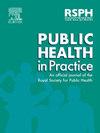Implementation of health warnings on alcoholic beverages in Spain
IF 1.9
Q2 PUBLIC, ENVIRONMENTAL & OCCUPATIONAL HEALTH
引用次数: 0
Abstract
Introduction
The objective of this study is to estimate the frequency and characteristics of health warning labeling on alcoholic beverages in Spain.
Study design
Cross-sectional study conducted in Madrid, Spain, between March and April 2023.
Methods
A convenience sample was designed by selecting four supermarket chains with a 40 % share of food distribution and two specialized alcohol stores. A total of 627 products were examined: 170 beers, 306 wines and sparkling wines, 68 liquors, 48 vermouths and aperitifs, and 35 other types of alcoholic beverages. Fisher's exact test statistically evaluated differences in labeling across beverage types.
Results
One or more health warnings were observed on 63.0 % of the products, with the most frequent being a recommendation against consumption during pregnancy (56.5 %), followed by recommendations against consumption by minors (19.0 %), and while driving (9.1 %). Only 9.1 % of the labels displayed two warnings, and 6.2 % displayed three. Significant differences were observed according to beverage type (p < 0.001), with the beer products presenting the highest frequency of displaying at least one warning (81.8 %), and liquors presenting the lowest frequency (50 %).
Conclusions
In Spain, alcohol industry's adherence to its own voluntary labeling guidelines of health warnings is low and inconsistent across type of beverages.
西班牙在酒精饮料上实施健康警告
本研究的目的是估计西班牙酒精饮料健康警告标签的频率和特征。研究设计横断面研究于2023年3月至4月在西班牙马德里进行。方法选择4家食品连锁超市和2家酒类专卖店,设计便利性样本。总共检查了627种产品:170种啤酒,306种葡萄酒和起泡酒,68种白酒,48种苦艾酒和开胃酒,以及35种其他酒精饮料。费雪的精确检验统计地评估了不同饮料类型在标签上的差异。结果63.0%的产品有一个或多个健康警示,其中建议孕期勿食用最多(56.5%),未成年人勿食用次之(19.0%),开车勿食用次之(9.1%)。只有9.1%的标签显示两个警告,6.2%显示三个警告。根据饮料类型,观察到显著差异(p <;0.001),其中显示至少一个警告的频率最高的是啤酒产品(81.8%),最低的是白酒(50%)。在西班牙,酒精行业对自己的健康警告自愿标签准则的遵守程度很低,而且在不同类型的饮料中不一致。
本文章由计算机程序翻译,如有差异,请以英文原文为准。
求助全文
约1分钟内获得全文
求助全文

 求助内容:
求助内容: 应助结果提醒方式:
应助结果提醒方式:


